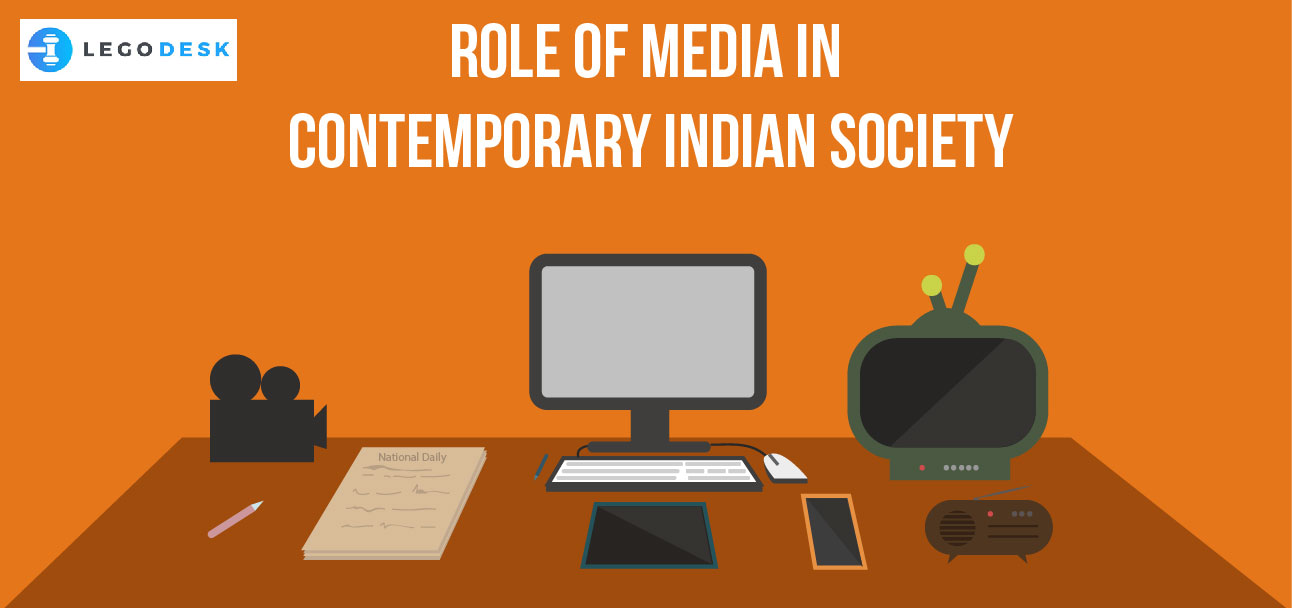Role of Media in Democracy Contemporary Indian Society

Article on Role of Media |
Freedom of the press has always been a valued right in all democracies. “Growth and development of representative democracy is so much intertwined with the growth of press that the press has come to be recognized as an ‘institutional limb of modern democracy.’[1] Democracy, political experts always say there are four pillars of democracy, namely the judiciary, executive, legislative, and media. Media plays an important role in shaping the outlook of the society and is capable of altering the entire perspective through which individuals see various events.
In India, the media has been responsible for preventing corruption and injustice and an organization which brings truth without any filters, to the people.
Role of Media in Democracy |
The Constitution of India in Article 19(1) (a) lays down that “all citizens shall have the right to freedom of speech and expression. The Indian Constitution does not explicitly mention the freedom of press/media but it is quite evident that the words “speech and expression” include freedom of the press also.
However, this right is not an absolute right, it is subject to reasonable restrictions.
Role of media in India |
In Romesh Thapar v/s State of Madras,[2] Patanjali Shastri,CJ, observed that “Freedom of speech of the press lay at the foundation of all democratic organization, for without free political discussion no public education, so essential for the proper functioning of the process of popular government, is possible.” In the said case, entry and circulation of the English journal “Cross Road”, printed and published in Bombay, was banned by the Government of Madras. The same was held to violate the freedom of speech and expression, as “without liberty of circulation, the publication would be of little value”.
The Hon’ble Supreme Court observed in Union of India v/s Association for Democratic Reforms, “One-sided information, disinformation, misinformation, and non-information, all equally create an uninformed citizenry which makes democracy a farce. Freedom of speech and expression includes the right to impart and receive information which includes freedom to hold opinions”.
In Indian Express Newspapers v/s Union of India, it has been held that the press plays a very significant role in the democratic machinery. The courts have a duty to uphold the freedom of the press and invalidate all laws and administrative actions that abridge that freedom. Freedom of the press has three essential elements. They are:
1. freedom of access to all sources of information,
2. Freedom of publication, and
3. Freedom of circulation.
There are many instances when the freedom of the press has been suppressed by the legislature. In Sakal Papers v/s Union of India, the Daily Newspapers (Price and Page) Order, 1960, which fixed the number of pages and size which a newspaper could publish at a price was held to be violative of freedom of the press and not a reasonable restriction under the Article 19(2). Similarly, in Bennett Coleman and Co. v/s Union of India, the validity of the Newsprint Control Order, which fixed the maximum number of pages, was struck down by the Court holding it to be violative of provision of Article 19(1)(a) and not to be reasonable restriction under Article 19(2). The Court also rejected the plea of the Government that it would help small newspapers to grow.
Media has a great influence on human life, it shows the public the realities of the world, the status of implementation of government policies and various other things involving our day to day life.
Women in Media
Media has a very significant role to play when it comes to women’s emancipation and struggle for women’s rights but unfortunately, gender inequalities in the media industry still exist and are very prominent.
While Media portrays to work for women empowerment and equal rights, the number of women employed in media itself is saddening. There has been very little progress.
The Global Media Monitoring Project 2015 in its report revealed that only 37 percent of all stories, including in newspapers and television, were reported by women. This was the same figure a decade ago. No progress has been made. Online, however, women’s representation was 42 percent.
Another report by the International Federation of Journalists, specific to the Asia-Pacific region, revealed that, although the presence of women in the region doubled in the last two decades, women still comprised just 28.6 percent of the total workforce.
One reason for such a condition of women is gender inequality, patriarchal norms, and discrimination. This absence of gender sensitivity is evident from the simple fact that the media has neglected its responsibility to annihilate gender-based stereotyping.
While one can, in any case, find women columnists in the desk section, magazine or the features department, not very many can be found on the field to report critical cases like legislative issues, criminal justice, technology, sports, business and so on. Additionally, at whatever point a women’s issue emerges, women are asked to cover them.
There is a whole power dynamic at play, men are as still pulling the strings in TV and daily papers. Women have that power of decision-making very rarely and are no place near to becoming equal creators of news. Unless and until this issue of unequal work is tended to, nothing can be changed.
In this way, with the end goal to empower women and to eliminate the gender gap, it is important that they are given the decision making power and equal representation.
[1] Vide Author, Commentary on the Constitution (6th Ed, Vol C, pg 95-97)
[2] Romesh Thapar v. State of Madras AIR 1950 SC 124.

